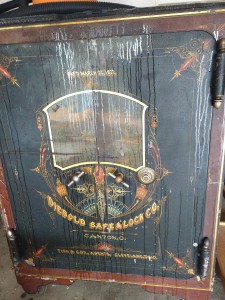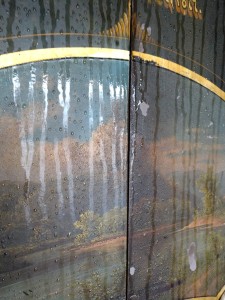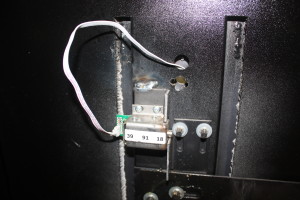When your safe or gun safe needs service you should contact a real safe company, rather than a locksmith. This is especially true if the safe is locked shut and needs to be opened. Safe technicians have more knowledge and experience in this area than a traditional locksmith. They also have specialized tools to do the work properly.
The pictures show an Auto Dialer connected to a gun safe that we recently opened. These specialized machines are great for some situations where a safe with a mechanical combination lock is in good working order but the combination is unknown. The Auto Dialer is mounted on the front of the safe, gripping jaws are attached to the lock dial and electronics are then programmed. When turned on the Auto Dialer will systematically dial every one of the 1,000,000 possible combinations on standard Group 2 mechanical locks. When everything works properly the machine comes to a stop at the right number, and a display shows you the combination.
The advantage of opening a safe this way is that there is no drilling, no holes at all to compromise the unit’s security. No damage to the paint either.
Very few of these machines are out there. They are expensive and a traditional locksmith is unlikely to own one. For obvious reasons not everyone is able to purchase an Auto Dialer. In fact, I have always suspected the FBI has a file on me as a result of owning one.
While the Auto Dialer is great for some situations there are many limitations which keep it from being an “every day” tool:
- Auto dialers only work on certain types of mechanical locks. They work on standard three wheel Group 2 locks, locks that mimic Group 2, and several other types. They do not work on Group 2M, Group 1, Group 1M, and many old locks. Sometimes the type of lock on a safe is difficult to determine, which makes a safe tech’s knowledge and experience important.
- Auto Dialers can work fast and don’t take breaks, but they can still take a long time to find the combination. Think about how many combinations “a million” really are. You might get lucky and get the combination in an hour if the combo’s first number is low. But when set on the fastest speed it can still take three straight days if the first number is high. Some locks, for a number of reasons, need to be run at slow speeds so it can actually take as long as two weeks! Occasionally the process can be shortened. For instance, if it is suspected that the combination was a “MM-DD-YY date”, these can all be run quickly. If it is known that the safe owner only used “zero and five” numbers for ease of dialing, these possible combinations can also be run quickly. If the first or second number is known for certain, that dramatically reduces the number of combinations that need to be dialed.
- The lock needs to be in good working order. Certain parts inside the lock might move too freely or may bind up. Dirt in the lock or old grease can prevent proper movement of parts. Parts can also be too worn for the machine to work.
- The very process of using the Auto Dialer can wear out the lock before finding the right combination. If the machine needs to run a long time, that by itself will be more work than most locks see in a hundred years. Even when the machine opens the safe we frequently replace the lock due to wear from the process.
- It is not worth hooking up the machine to locks with plastic or nylon parts. They will almost certainly not last long enough for the combination to be found.
- Potential for theft of the machine severely limits where we can use it. We don’t want to be responsible for the wrong person getting their hands on an Auto Dialer. As a result we seldom use it in the field. We usually use it here in the shop when someone brings a safe to us. It can run in the back room for hours or days without us worrying about it.
- There are times when everything seems to be perfect, but the machine just plain cannot find the numbers it is looking for. It may take two weeks, dial every combination, and still give the message “Combination Not Found”. Then you still need to drill the safe.
The Auto Dialer is certainly not the Silver Bullet cure-all. It is a good tool when people bring us locked safes they bought at auction, or they inherit Grandpa’s safe, the combination for which he took to the grave. Maybe they just forgot the combo and lost that little piece of paper with the numbers. Few locksmiths have this tool, or the other specialized gizmos we have. It takes lots of special, expensive tools, along with lots of experience to be really good at vault door or safe work. Look for that kind of company when you need safe service.
As I write this our Auto Dialer is in the back working on a vault we bought yesterday. It has not been opened in 20 years. It has the right kind of lock, the lock seems to be working well, the machine has tried about 35,000 combinations so far without stopping. I just KNOW that this is THE ONE – the safe packed with silver and gold bars that will allow me to retire . . .










